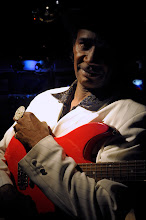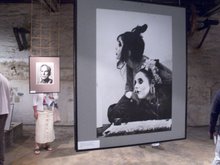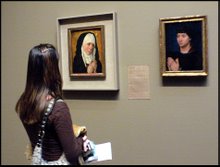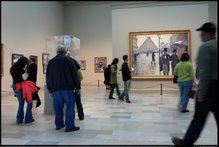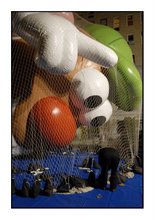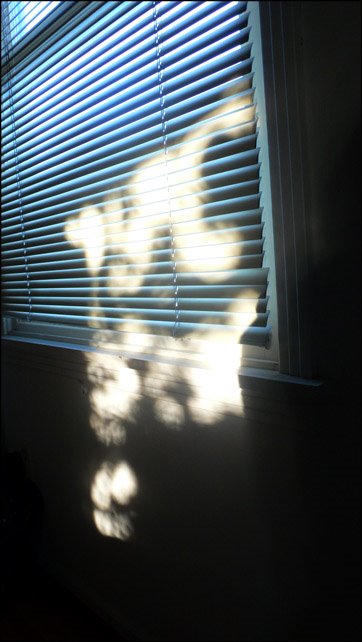Sponsoring the Fine Arts: Whose Responsibility.
The Fine Arts As Expression of a Specific Culture
All successful cultures and civilizations have expressed their achievements, power, sophistication and wealth through the hands of an elite of their skilled, talented, experienced, and creative members/workers
Let us first go back to the original meaning of “art”: a set of perfected skills, the result of training and practice in a particular domain. These skills are applied to raw materials for the production of our physical and intellectual environment (everyday objects, tools, but also books or music).
By extension, during the Italian Renaissance, in Florence, arte (or arti in the plural) designated groups of professionals sharing the same interests in their trades or occupations. Arte was a synonym for trade association or guild. The arti controlled the training, education, quality of execution, pricing of their members. These communities created close ties and a shared feeling of responsibility toward the image of the group in the eyes of others and in their own eyes. They often sought the expression of their power, success, and sophistication through the production (and financing) of refined cultural objects expressing their values in esthetic and metaphoric terms. This engendered the notion of “Fine Arts.”
In the pursuit of such ideals and absolute as “truth” or “beauty,” refined artifacts had to be the created by an elite of craftsmen thoroughly mastering their tools. Thence, after the craftsmen, came the artists and soon with them, financers and sponsors. Because of the goals and content of the fine arts, because of their high production cost–linked to their makers’ excellence in skills and creativity–, because of the dedication, time, resource that such activities entail, the financers of the fine arts have always been the political, financial, religious powers, and wealthy individuals. All three powers have the means to collect money from the members of their societies, and invest it in expressions of the human mind (cultural production). Taxes, profits, alms, gifts are ways that help a society function, part of the “social contract.” The need and benefits of investing the resource of a community in cultural productions are manifold. Fine art objects are expressions of the soul of the very communities that finance them.
Of religious sponsoring of the arts
Let us, now, have a look at the current state of affairs in our (fine) art world. The church(es), or other metaphysical unifiers and spiritual powers, some of the most active sponsors of the arts of the past, have drastically shrunk their support to the fine arts due to their loss of control, and financial clout, as well as of a situation of disputed relevance and competition.
The National Endowment for the Arts
The political support of the fine arts, after the hay-days of the National Endowment of the Arts (created in1965 as part of President Lyndon Johnson’s “Great Society” program), has also drastically shrunk. From 1965 to 2000–according to a report published by the NEA itself in 2000 and available on the web–the number of non-profit theaters was multiplied by six, opera companies by 5, symphony orchestras by two, dance companies by 18. During that period, the projects of thousands of American artists were directly sponsored by the NEA, and the United States became a truly dominant cultural power, and model–a position that is still reflected by its reigning status in the art market.
In the thirty years that followed its creation, the budget of the NEA had grown from some $ 3,000,000 in 1966 to close to $ 172,500,000 in 1993. Even taking inflation into account, it had been a very substantial increase. This, in a very profound way, has allowed the country to establish the most democratic means of producing images, photography, and by extension cinema as the two truly American fine-arts of the twentieth century. The American production in these fields has definitely excelled, and has served as a model for the rest of the world. If cinema has essentially been a capitalist venture (supported by investments and profits), fine-art photography owes its prominence to institutional and political support: educational institutions (especially universities), the NEA, and foundations such as the Guggenheim foundation–most prominently among many other foundations–and private sponsors (Chase, Exxon, Seagram, Hallmarks, Getty…). But the news is sad for artists, in our brave new world, share-holders reign, and anonymously dictate policies, want dollars in return for their financial investments. Ethical, responsible, philosophical investments have gradually taken a back seat at board-meetings as recently exemplified by Eron or Halliburton.
Regarding the public funding of the fine arts, from its $ 172,500,000 budget in 1994, the NEA went down to $ 99,500,000 in 1996. The same year, all individual artists’ fellowships were totally eliminated (except for literature fellowships).
How the market place can sometimes endanger depth and quality in a work of art
Today’s artists cannot rely on the social and cultural responsibility and generosity of institutions, whether private or public, in the way they used to. This may have dire consequences on the fine arts. It constantly causes the elimination of some serious artists from the art scene. The artists have to dedicate less time and serious investment in their works “to get a day job,” or produce less profound art to meet the immediate need of the market for decoration and entertainment–from the bubbly “fun art” of a Jeff Koons, to the provocative or shocking art (in spite of the classical form it usually assumes) made for the thrill and impact of it by such individuals as Damien Hirst, Matthew Barney, Andreas Serrano. There is sometimes a fine line between using “spectacle” as an ingredient of art, and using the disguise of fine art to only produce spectacle where real, humanistic, ethic content has disappeared, where the fine arts have been eviscerated of their quasi transcendental, if not sacred, content, role and value.
What history shows us
When expanding societies of tradesmen or warriors–the two are often combined–stop investing part of their revenues in the production of fine arts, this has always been, so far, the first signs of their demises and later decadences (the history of all great ancient cities, empires exemplifies this). The decrease in the production of fine art has often been the symptom of deeper crises. Do we want this to happen here, and be the ones responsible for it?
What can we do?
The solutions are the responsibility of every single citizen. The more prominent one is in one’s society, the more responsibilities are bestowed on her/him. The members of any democratic system can express their wishes to the bodies (Congress, Senate, County, City) that they elected. Policies can be made, changed to sponsor the arts. Individual citizens can also reinvest a part of the success of their professional activities into the sponsoring of the arts of their time. It is up to every single one of us to roll up our sleeves and pick up the responsibilities that others have relinquished, or failed to meet. It is up to us to do it in an enlightened and enlightening way. Supporting living artists, NOW, by buying their works, commissioning them is an easy step. It is often more economical to buy new contemporary art than the works of old masters. It makes more sense for the defense and promotion of the art of our time. It is the only way to bequeath a sense of who we are to the future generations. There are, of course, local artists of quality and depth all around us.
Bruno Chalifour
Artist, art critic and consultant.
Saturday, April 21, 2007
An assignment: On the Purpose of Art in the XXth Century.
Of the Evolution of Artistic Sensibilities.
PART 1: The Birth of Conceptual Art
The Fine Arts As Expression of a Specific Culture
All successful cultures and civilizations have expressed their achievements, power, sophistication and wealth through the hands of an elite of their skilled, talented, experienced, and creative members/workers
The original meaning of “art” was as follows: a set of perfected skills, the result of training and practice in a particular domain. These skills are applied to raw materials for the production of our physical and intellectual environment (everyday objects, tools, including books or music).
By extension, during the Italian Renaissance, in Florence, arte (or arti in the plural) designated groups of professionals sharing the same interests in their trades or occupations. Arte was a synonym for trade association or guild. The arti controlled the training, education of their members, as well as the quality of execution, and pricing of their performances. These communities created close ties and a shared a feeling of responsibility toward the image of the group in the eyes of others, and in their own eyes. They often sought the expression of their power, success, and sophistication through the production (and financing) of refined cultural objects expressing their values in esthetic and metaphoric terms. This engendered the notion of “Fine Arts.”
In the pursuit of the expression of such ideals and absolute as “truth” or “beauty,” or, even more mundanely, power, refined artifacts had to be the created by an elite of craftsmen thoroughly mastering their tools. Thence, after the craftsmen, came the artists who added heightened content, style, subjectivity to form, and soon with them, financers and sponsors. Because of the goals and content of the fine arts, because of their high production cost–linked to their makers’ excellence in skills and creativity, and the materials used–, because of the dedication, time, resource that such activities entail, the financers of the fine arts have always been the political, financial, religious powers, as well as wealthy individuals. All three powers have the means to collect money from the members of their societies, and invest it in expressions of the human mind (cultural production). Taxes, profits, alms, gifts are ways that help a society function; they are part of a “social contract” where a common “kitty” is created. The need and benefits of investing the resource of a community in cultural productions are manifold. Fine art objects are expressions of the soul of the very communities that finance them.
Revolutions
The eighteenth century ended with two great revolutions, the American one in 1776, the French one in 1789–the latter somewhat more radical than the former in that it not only eliminated royal power but in its wake the powers and influences of the whole nobility and the church, the two biggest sponsors of the fine arts so far–which would generate some changes in the motivations, goals, and expectations of artists.
The nineteenth century bought the industrial revolution and a different kind of financial and political power that would compete with land-based wealth and ultimately win.
In the western world, once the ideas of immutable power (kingly, inherited from a Christian god), religion had been deeply challenged, a whole area of the art world turned away from the “noble” subjects and the Greek and Roman antiquities, symbols of the Ancien Regime (the old classical political world), and became interested in more mundane subjects.
La Fée Photographie
With the industrial revolution came the perfect medium for its art: photography and the moving image. It shook the art world, painting, sculpture had to move forward. The notion of Avant-Garde was born. Artists had to think ahead of their time instead of looking back; they had to produce new work, generate new approaches, new ideas. Art started to look at itself, its value, function. Art for art’s sake became a leitmotiv, ¬and with it the poverty and bohemian life-style with which many artists became associated–Van Gogh being a perfect example. Classical salons were eclipsed by those showing the outrageous works of the avant-garde–the first Salon des Refusés opened in Paris in 1863.
After somewhat struggling with defining their role and status among the established arts–Pictorialism being one aspect of this quest, photography trying to emulate a painterly style and somewhat stray from the advantages of “mechanical reproduction”–photographers settled for what their tools could do best, and stopped emulating painters. Suddenly the painters found themselves freed of the burden of having to reproduce the visible world as faithfully as possible. With mechanization and technology, artists could spend more time on the ideas in their art, less on the process of making it. With this new approach came such smart artistic provocateurs as Marcel Duchamp, displaying a urinal baptized Fountain on the wall of a New York art show (The Society of Independent Artist exhibition) in 1917, trying to prove that the idea/concept was more important than the object, that the context in which a piece was seen also defined its status. An esthetic piece in the restroom of an inn is mere decoration (or “tool”), on a museum or gallery wall, in a prestigious private collection, it suddenly becomes art–the difference lies in the idea, the choice of the artist. Ready-made, minimal, and conceptual arts were born.
Bruno Chalifour
Artist, art critic and consultant for RenAnArt.com.
PART 1: The Birth of Conceptual Art
The Fine Arts As Expression of a Specific Culture
All successful cultures and civilizations have expressed their achievements, power, sophistication and wealth through the hands of an elite of their skilled, talented, experienced, and creative members/workers
The original meaning of “art” was as follows: a set of perfected skills, the result of training and practice in a particular domain. These skills are applied to raw materials for the production of our physical and intellectual environment (everyday objects, tools, including books or music).
By extension, during the Italian Renaissance, in Florence, arte (or arti in the plural) designated groups of professionals sharing the same interests in their trades or occupations. Arte was a synonym for trade association or guild. The arti controlled the training, education of their members, as well as the quality of execution, and pricing of their performances. These communities created close ties and a shared a feeling of responsibility toward the image of the group in the eyes of others, and in their own eyes. They often sought the expression of their power, success, and sophistication through the production (and financing) of refined cultural objects expressing their values in esthetic and metaphoric terms. This engendered the notion of “Fine Arts.”
In the pursuit of the expression of such ideals and absolute as “truth” or “beauty,” or, even more mundanely, power, refined artifacts had to be the created by an elite of craftsmen thoroughly mastering their tools. Thence, after the craftsmen, came the artists who added heightened content, style, subjectivity to form, and soon with them, financers and sponsors. Because of the goals and content of the fine arts, because of their high production cost–linked to their makers’ excellence in skills and creativity, and the materials used–, because of the dedication, time, resource that such activities entail, the financers of the fine arts have always been the political, financial, religious powers, as well as wealthy individuals. All three powers have the means to collect money from the members of their societies, and invest it in expressions of the human mind (cultural production). Taxes, profits, alms, gifts are ways that help a society function; they are part of a “social contract” where a common “kitty” is created. The need and benefits of investing the resource of a community in cultural productions are manifold. Fine art objects are expressions of the soul of the very communities that finance them.
Revolutions
The eighteenth century ended with two great revolutions, the American one in 1776, the French one in 1789–the latter somewhat more radical than the former in that it not only eliminated royal power but in its wake the powers and influences of the whole nobility and the church, the two biggest sponsors of the fine arts so far–which would generate some changes in the motivations, goals, and expectations of artists.
The nineteenth century bought the industrial revolution and a different kind of financial and political power that would compete with land-based wealth and ultimately win.
In the western world, once the ideas of immutable power (kingly, inherited from a Christian god), religion had been deeply challenged, a whole area of the art world turned away from the “noble” subjects and the Greek and Roman antiquities, symbols of the Ancien Regime (the old classical political world), and became interested in more mundane subjects.
La Fée Photographie
With the industrial revolution came the perfect medium for its art: photography and the moving image. It shook the art world, painting, sculpture had to move forward. The notion of Avant-Garde was born. Artists had to think ahead of their time instead of looking back; they had to produce new work, generate new approaches, new ideas. Art started to look at itself, its value, function. Art for art’s sake became a leitmotiv, ¬and with it the poverty and bohemian life-style with which many artists became associated–Van Gogh being a perfect example. Classical salons were eclipsed by those showing the outrageous works of the avant-garde–the first Salon des Refusés opened in Paris in 1863.
After somewhat struggling with defining their role and status among the established arts–Pictorialism being one aspect of this quest, photography trying to emulate a painterly style and somewhat stray from the advantages of “mechanical reproduction”–photographers settled for what their tools could do best, and stopped emulating painters. Suddenly the painters found themselves freed of the burden of having to reproduce the visible world as faithfully as possible. With mechanization and technology, artists could spend more time on the ideas in their art, less on the process of making it. With this new approach came such smart artistic provocateurs as Marcel Duchamp, displaying a urinal baptized Fountain on the wall of a New York art show (The Society of Independent Artist exhibition) in 1917, trying to prove that the idea/concept was more important than the object, that the context in which a piece was seen also defined its status. An esthetic piece in the restroom of an inn is mere decoration (or “tool”), on a museum or gallery wall, in a prestigious private collection, it suddenly becomes art–the difference lies in the idea, the choice of the artist. Ready-made, minimal, and conceptual arts were born.
Bruno Chalifour
Artist, art critic and consultant for RenAnArt.com.
Subscribe to:
Posts (Atom)

